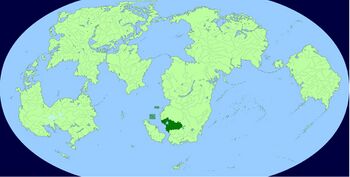Afrasha
Dominion of Afrasha Mulkin na Afrasha | |
|---|---|
|
Flag | |
| Motto: "Mu sama da duka" (Hausa) "We above all." | |
 | |
| Capital | Nagono |
| Largest city | Migoran |
| Official languages | Hausa |
| Ethnic groups |
|
| Demonym(s) | Afrashan |
| Government | Unitary Totalitarian Hereditary Dictatorship |
| Tinorma Vilya | |
| Minano Dinwa | |
| Legislature | National Council |
| Population | |
• 14 estimate | 72,410.148 |
• 10 census | 69.896.448 |
| GDP (nominal) | 10 estimate |
• Total | $720.982 billion |
• Per capita | $10,315 |
| Gini (10) | medium |
| HDI (10) | high |
| Currency | Afrashan Vil (AFV) |
| Date format | dd/mm/yyyy |
| Driving side | right |
| Calling code | +44 |
| Internet TLD | .af |
Afrasha officially the Dominion of Afrasha is a country in southwestern continent bordered by countries. Afrasha is an advanced nation that focuses on domination and expansion. The country has been ruled by the Vilya family for over 700 years after the royal family was overthrown in 721 B.W. Since then, the Vilyas have had varying types of rule. Currently, the country is experiencing an economic and scientific boom which has fueled the expansionist ideology of the people and government. The Nora and Natusha Islands have aided in Afrashan maritime expansion and trade, expanding their sphere of influence.
Etymology
History
Geography
Government and Politics
The government of Afrasha is under the direct control of the Supreme Leader, including the Nation Council. Political rights are heavily supressed and elections are restricted to only those with approval from the Supreme Leader. The government is split into three branches: executive, legsislative, and judiciary. The executive is made of the Supreme Leader who has complete power and the final say in all governmental actions. The first born child of a Supreme Leader will become the secceeding Supreme Leader, unless the Supreme Leader chooses otherwise. No one outside of the Vilya family has any control over the executive branch of government. The legislative is made of the National Council headed by the Grand General. The National Council is made of 72 members, 36 elected and 36 appointed by the Supreme Leader to five year terms. The National Council can make recomendations to the Supreme Leader, however they hold very little power. The Grand General is appointed by the Supreme Leader and ensures executive orders and laws are carried out. The judiciary is tasked with keeping the law and is made of a system of high, medium, and low courts. The high courts are used for high-profile cases, cases with national consequences, and cases that cross province borders. The medium courts are used in the same way, but at the provincial level. The low courts are used in local jurisdictions and minor cases. All judges are appointed by the Supreme Leader or a province premier.
